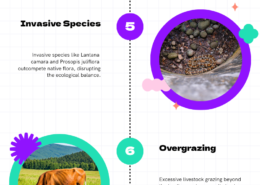Answer should include potential advancements in AI technology and its impact on society, including benefits and ethical concerns. It will also address the balance between leveraging AI for progress and maintaining human autonomy.
India’s natural vegetation is incredibly diverse, but it faces several significant threats. Here are the major threats to vegetation in India, which you can use to create an infographic: 1. Deforestation Causes: Logging, agriculture, urbanization, and infrastructure development. Impact: Loss of habiRead more
India’s natural vegetation is incredibly diverse, but it faces several significant threats. Here are the major threats to vegetation in India, which you can use to create an infographic:
1. Deforestation
- Causes: Logging, agriculture, urbanization, and infrastructure development.
- Impact: Loss of habitat, reduction in biodiversity, and disruption of ecosystems.
2. Urbanization
- Causes: Expansion of cities and towns.
- Impact: Conversion of natural landscapes into urban areas, leading to habitat fragmentation and loss.
3. Pollution
- Causes: Industrial activities, vehicular emissions, and agricultural runoff.
- Impact: Soil degradation, water contamination, and adverse effects on plant health.
4. Climate Change
- Causes: Global warming, changes in precipitation patterns, and extreme weather events.
- Impact: Altered growth patterns, increased vulnerability to pests and diseases, and shifts in vegetation zones.
5. Invasive Species
- Examples: Lantana camara, Chromolaena odorata, and Prosopis juliflora.
- Impact: Competition with native species, alteration of habitats, and disruption of ecological balance.
6. Overgrazing
- Causes: Livestock grazing beyond the carrying capacity of the land.
- Impact: Soil erosion, loss of plant cover, and degradation of grasslands.
7. Mining
- Causes: Extraction of minerals and resources.
- Impact: Destruction of vegetation, soil erosion, and pollution of water bodies.
8. Overexploitation
- Causes: Unsustainable harvesting of timber, medicinal plants, and other forest products.
- Impact: Depletion of resources and loss of biodiversity.
9. Habitat Destruction
- Causes: Infrastructure projects, agriculture, and human settlements.
- Impact: Loss of natural habitats, fragmentation, and decline in wildlife populations.
10. Decline of Pollinators
- Causes: Pesticide use, habitat loss, and climate change.
- Impact: Reduced pollination, affecting plant reproduction and crop yields.
These threats collectively pose a significant challenge to the conservation of India’s natural vegetation. Addressing these issues requires coordinated efforts in conservation, sustainable practices, and policy implementation.
See less

The future of artificial intelligence (AI) promises significant advancements and profound impacts on society. Potential advancements in AI technology include more sophisticated machine learning algorithms, enhanced natural language processing, advanced robotics, and AI systems capable of complex decRead more
The future of artificial intelligence (AI) promises significant advancements and profound impacts on society. Potential advancements in AI technology include more sophisticated machine learning algorithms, enhanced natural language processing, advanced robotics, and AI systems capable of complex decision-making. These developments could revolutionize industries such as healthcare, finance, education, and transportation, leading to improved efficiency, new innovations, and enhanced quality of life. For instance, AI-driven diagnostics can enable early disease detection, while intelligent tutoring systems can provide personalized education experiences.
However, these advancements bring both benefits and ethical concerns. On the positive side, AI can alleviate mundane and repetitive tasks, allowing humans to focus on more creative and strategic activities. It can also democratize access to information and resources, bridge gaps in education, and facilitate smarter urban planning. Nevertheless, there are significant ethical considerations to address, such as data privacy, algorithmic bias, and the potential for job displacement. Ensuring that AI systems are transparent, fair, and accountable is crucial to mitigate these risks.
A key concern is the balance between leveraging AI for progress and maintaining human autonomy. While AI can greatly augment human capabilities, there is a risk of becoming overly dependent on these systems, which might erode critical thinking and decision-making skills. It is essential to foster an environment where AI serves as a tool to empower humans rather than a replacement for human judgment and agency.
The effects of AI on children are particularly significant. On one hand, AI can provide personalized learning experiences, enhance educational outcomes, and improve accessibility to quality education. On the other hand, excessive reliance on AI-driven devices and platforms may impact children’s social skills, creativity, and critical thinking. Additionally, the exposure to algorithmic content curation raises concerns about screen time, privacy, and the potential for reinforcing biases or harmful stereotypes.
To navigate these challenges, it is imperative to promote responsible AI use through education, regulation, and societal awareness. Encouraging critical thinking, digital literacy, and ethical considerations from a young age can help children become informed and conscientious users of AI technology. By striking a balance between innovation and ethical responsibility, society can harness the potential of AI while preserving human dignity and autonomy.
See less